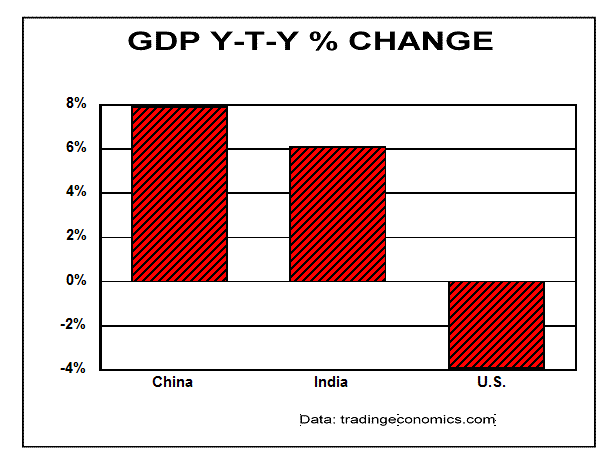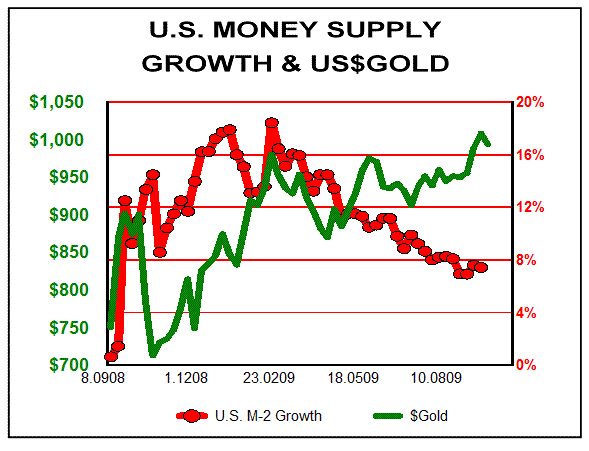Gold $1,700+ Driven by Massive Debt Monetization
Commodities / Gold & Silver 2009 Sep 29, 2009 - 01:58 AM GMTBy: Ned_W_Schmidt
 Suppose one was a football coach, whatever kind of football you like. You have a play that has been used in every game in the season thus far. Each time the play was executed, it failed. What would you as coach do?
Suppose one was a football coach, whatever kind of football you like. You have a play that has been used in every game in the season thus far. Each time the play was executed, it failed. What would you as coach do?

Yes, most coaches would toss the play, and never use it again. However, if one's college degree was in economics, the response would be quite different. Those economics trained coaches would just keep using that same play, despite all evidence that it does not work.
Now, consider the results posted in our first chart, below. In the world game of economics, some winners and losers exist. Can you determine the loser? The winners?
The reason China and India are experiencing economic growth is that real change has been instituted in those countries. They, admittedly at their own glacial speed, are reducing the interference of government in the economy. As that happens, engines of economic growth have developed. Companies are building factories and hiring people. The government is building infrastructure that fosters and encourages growth.
U.S., however, continues to pursue and promote the failed economic policies of the past. As the U.S. continues under the growth killing dogma of Keynesian economics, few prospects for economic growth are evident. Chinese and Indian business people are building real business, while the U.S. twitters its future away. We note that Germans handed Merkel a victory this past weekend, and she will now proceed to cut taxes. Why is the U.S. the leader in taxation and regulation when those policies are so clearly economic growth killers? Gold, alas, is really the only long-term investment choice for North American investors as long as wealth destruction is the end result of Obama Regime policies.
Regrettably, the fading Obama Regime is indeed bringing change. By leveraging higher the interference of government in the economy, the prospects for economic growth have changed for the worse. Yes, government spending can stop an economic slide, No, it cannot create those engines of economic growth that are needed. The real change needed out of the Obama Regime is to kill off Keynesian economics, which essentially advocates replacing the private sector with government bureaucrats, once and for all.
Not surprisingly, the greatest failure of U.S. government policy making continues to be the bastion of employment for economists. The Federal Reserve can be deemed nothing but an abject failure. It gave us the internet stock bubble. It then created the mortgage/housing bubble and collapse. It has helped to turn U.S. financial institutions into subsidiaries of the U.S. government rather than being financial intermediaries serving the economy. Let us now turn to the latest round of monetary havoc that has been inflicted on the U.S. by the Federal Reserve, in the chart below.

U.S. money supply expanded sharply as the Federal Reserve panicked in the wake of the financial problems of last year. One would have thought the world was ending the way they behaved. That action offset the collapse of private credit to all those dubious ventures that the Federal Reserve and other elements of government had previously encouraged. All of that monetary panic at the Federal Reserve caused the U.S. money supply to expand explosively, until February.
However, since February the U.S. money supply has not grown, and has actually contracted. That development has implications for the U.S. economy, the value of the dollar, and the dollar price of Gold. Lack of money supply growth is an indication of a lack of true economic growth. Without private credit creation, neither the money supply nor the U.S. economy will grow naturally. Government spending, evidenced by the $2 trillion deficit, is not economic growth, but simply money wasted on baubles from Wal-Mart.
To understand better the implications of the stagnant U.S. money supply, let us take a look at the growth rate of the U.S. money supply while also considering the value of $Gold. That has been done in our second graph, below. In that graph is plotted the growth rate of the U.S. money supply with a line of red circles using the right axis, since August of last year when panic over the financial crisis reached a high. That line is the cumulative annualized growth of the U.S. money supply since then. The growth rate of U.S. money supply is a more meaningful measure as it is the growth rate, and in particular the second derivative of the growth rate, that influences the price of $Gold, the dollar, and the U.S. economy. The green line is the monthly average price of US$Gold.

In the early part of the graph the growth rate of the U.S. money supply exploded upward, from essentially zero to about 18%. $Gold diverged from that growth rate for a short period of time as liquidating hedge funds were forced to sell assets. That divergence could not, and did not, last as an exploding U.S. money supply eventually causes the supply of dollars to be excessive, pushing down the value of those dollars. As that happened, $Gold moved sharply higher.
Now, note the trend in the growth rate for the U.S. money supply. The second derivative is now decidedly negative. Dollars are become relatively rarer. At the present time the U.S. dollar is extremely over sold, as selling dollars has become the favorite trade of momentum players. At the same time, analysts have been making outrageous claims that the U.S. dollar would disappear, perhaps by the end of the year. Some gullible investors have been taken in by such talk.
Divergence between the growth rate of the U.S. money supply and $Gold is readily evident in the early part of the graph. U.S. money supply growth was exploding upward. At the same time the price of $Gold went lower as liquidating hedge funds were forced to sell all kinds of positions. However, that divergence was not sustainable, and the price of $Gold ultimately moved sharply higher.
Now, the divergence is of another kind. The growth rate of U.S. money supply is moving down while $Gold has been pushed up by trend chasing momentum players. A slowing of the growth rate for the U.S. money supply should, in the short-term, make the dollar more valuable on a relative basis. As a consequence, the price of $Gold could move lower, perhaps to less than US$950, where it would be again a buy. This negative monetary growth situation also has negative implications for U.S. paper asset markets.
Non U.S. dollar denominated investors should, as that is happening to $Gold, experience higher prices. Gold in both Canadian dollars and Euros will likely soon break to the upside out of lateral patterns that have been built. British Pound Gold appears to have already broken out of the lateral pattern. That action is probably due to the election to be held by June, and perhaps fear that the current government might remain in power. Current British government ranks second only to the Obama Regime in wealth destruction policies. British investors should be maximizing their Gold holdings versus domestic assets.
Now, less this analyst sound too negative, the longer term case remains intact. The Federal Reserve will eventually respond to the negative implications of slowing U.S. money supply growth. We can expect near full monetization of the Obama Regime's massive deficits in the future. Ultimately, the Federal Reserve will be forced to "deliver cash by trucks" to the U.S. Treasury to finance that deficit. That will get us back on the glory road for $Gold to US$1,700+.
By Ned W Schmidt CFA, CEBS
Copyright © 2009 Ned W. Schmidt - All Rights Reserved
GOLD THOUGHTS come from Ned W. Schmidt,CFA,CEBS, publisher of The Value View Gold Report , monthly, and Trading Thoughts , weekly. To receive copies of recent reports, go to http://home.att.net/~nwschmidt/Order_Gold_GETVVGR.html
Ned W Schmidt Archive |
© 2005-2022 http://www.MarketOracle.co.uk - The Market Oracle is a FREE Daily Financial Markets Analysis & Forecasting online publication.



